
* Corresponding author Tel.: +84788335787
E-mail address: damnguyetha24@gmail.com (H.N. Dam)
© 2020 by the authors; licensee Growing Science.
doi: 10.5267/j.uscm.2020.5.003
Uncertain Supply Chain Management 8 (2020) 439–456
Contents lists available at GrowingScience
Uncertain Supply Chain Management
home
p
a
g
e: www.Growin
g
Science.com/usc
m
The determinants of customer’s intention to use international payment services by applying
blockchain
Ha Nguyet Dama*, Dung Thanh Phana, Duc Tien Vub and Lan Thi Ngoc Nguyenc
aExcellent Banking 59, School of Advanced Educational Programs, National Economics University, Vietnam
bBusiness Analytics 61, School of Advanced Educational Programs, National Economics University, Vietnam
cSchool of Economics, Finance and Management, The University of Bristol, United Kingdom
C H R O N I C L E A B S T R A C T
Article history:
Received January 29, 2020
Received in revised format March
27, 2020
Accepted May 9 2020
Available online
Ma
y
9 2020
This study aims to shed light on the way customers determine their utilization of international
payment services with blockchain applications. The primary data is collected from the 373
individuals who frequently use the international payment services in Vietnam. We apply the
combination of TAM, UTAUT, and ISS models to test the determinants of the Intention to use
International payment services at Commercial banks applying Blockchain. These determinants
are Quality of System, Quality of Service, Quality of Information, Perceivable usefulness,
Convenient usefulness, and Social influence. The research results show that (i) All of the above
factors are positively associated with customers’ intention to use international payment
services in Vietnamese banks which implement blockchain; (ii) The quality of information has
the strongest positive impact on the customer's intended use. It refers that the international
payment services in banks should be safe, accurate and timely; (iii) Differently from the
hypothesis, the social influence indicator is positively related to the customer's intention to use
the service, affirming the potential interests of customers on blockchain if applying
successfully in banks; (iv) Although current customers have not paid much attention whether
banks apply blockchain in international payment or not, they have taken concentration on
fundamental risks, costs, and convenience of the services. This signal is consistent with the
fact that only 2/46 commercial banks and 49 foreign bank branches in Vietnam provide
international payment service with blockchain application nowadays.
.s; license Growin
g
Science, Canada2020 b
y
the author©
Keywords:
Blockchain
Commercial Banks
Determinants
Intention to use
International payment
1. Introduction
International payments continue to grow, but technological progress poses an extremely urgent
challenge for the incumbents, especially in banking industry. This is because these banks were
developed in a time when communications were costly, slow, and unreliable. Now, another problem
these banks have to face is the increasing demand for a faster and more convenient digital standard of
International payment services (Faden, 2019). Regulatory activism, on the other hand, is driving up the
complexity and costs of compliance in delivering international payments. This pushes the service
industry towards a profound transformation which requires the integration of advanced technology, the
enhancement of international payment services. Global banking giants will find themselves in a strong

440
position as long as they invent and reinvent themselves. By contrast, small domestic banks will continue
to outsource the activities in which they are subscale, including applying technology to international
payments. Mid-sized banks will face the toughest strategic options (Barbey et al., 2017).
Blockchain is the general term for distributed ledger technology (DLT) distributed on many systems
(tamper-proof). According to Mr. Sanjay Chakrabarty - Deputy General Director of Orient Commercial
Bank (OCB) - with blockchain, people find it easier, faster, more convenient, and more secure when
they make financial transactions or investment decisions than the traditional way (OCB, 2019).
Blockchain is the underlying technology that creates virtual currencies like Bitcoin and Ethereum, and
furthermore, involves directly in streamline transaction processes, making them more efficient and
economical. Traditionally, banking and payment transactions have relied on a central authority or
middleman to make payments, resulting negatively in the transparency, timeliness, and reliability in
recognizing and managing these translations. The Blockchain appears to overcome these problems, to
allows a distributed computer network to reach consensus without the need for this middleman (Belin,
2008).
Practically blockchain has become more and more and more popular since 2017 when banking services
witnessed many collapses in Irish, Spanish and Icelandic. In European countries, IBM has developed a
new blockchain technology that will be used by seven of Europe's largest banks, including Deutsche
Bank, HSBC, KBC, Natixis, Rabobank, Societe Generale, and Unicredit to promote international trades
for small and medium-sized businesses (Kharpal, 2017). In Asia, OCBC Bank is the first bank in the
world to use Blockchain technology in domestic and international remittance services, increasing
efficiency, transparency, reducing costs and improving customer experience (OCBC, 2016). In
Vietnam, in July 2018, NAPAS cooperated with three banks including VietinBank, VIB and TPBank
to successfully conduct interbank money transfer transactions using Blockchain. TP Bank is the first
bank to apply Blockchain in money transfer while HSBC has successfully implemented Letter of Credit
(L/C) transactions on the Blockchain platform between two large enterprises in plastic market (TPBank,
2019). This confirms the popularity of Blockchain platforms in international payment systems of
commercial banks. However, it is no doubt to say that scholars do not pay much attention on customers'
decision to use international payment services at banks that have applied blockchain, resulting to a
relatively shortage in the literature review.
Theoretically, one study about the application of Blockchain in the International Payment system found
that the blockchain platform can help banks form a faster, more flexible and secure international
payment system (Chen and Hayashikawa, 2018). Therefore, the implementation of general research on
applying Blockchain is necessary at this moment for banks and its clients, even with little empirical
evidence worldwide. Empirically, TAM, UTAUT, ISS models have been applied to investigate the
determinants of customers' decision to use online services such as online shopping, e-banking services
and 3G services (Ly, 2018; Dung, 2019). Thus, we will apply these models to analyze the topic:
“Determinants of customers' decision to use International Payment Services at Commercial banks
Applying Blockchain Platform in Vietnam”.
2. Literature review
2.1. Three models on determinants of customers’ decisions
As mentioned above, Technology Acceptance Model (TAM), UTAUT, and ISS are three famous
models in analyzing the determinants of customers’ intention, especially popular in developing
countries. TAM, originally introduced by Davis et al. (1989), illustrates the degree to which a person
believes that using a system would enhance his or her job performance. UTAUT is a combination of
many factors from other theoretical models with the goal of creating a common perspective for users
with new information systems. The combination is among TRA, TPB, TAM, motivation models,

H.N. Dam et al. /Uncertain Supply Chain Management
8 (2020) 441
innovation diffusion theory (IDT), social cognitive theory (Social Cognitive Theory) (Venkatesh et al.,
2003). Developed by Delone and Mclean (1992), ISS is commonly used to measure the success of
information technology systems under users’ evaluation (Smith & Kumar, 2003). There should be an
overlap between the TAM and UTAUT models in the convenient usefulness, the intended to use, and
behavior to use variables. As for the ISS model, which was built to evaluate the satisfaction of the new
technology system, it overlaps the TAM and UTAUT models in the independent variable Intended to
use.
In the study Adoption of Blockchains - A Cross Cultural Comparison by Franziska (2016), UTAUT
and TAM models are applied to assess the impact of performance expectancy, effort expectancy, social
influence, facilitating conditions, and some regulatory variables such as habit, culture on behavioral
intention. Similarly, Kim and Gim (2017) analyze factors influencing the intention to accept blockchain
based on UTAUT. They point out that five factors related to the performance expectancy and effort
expectancy are associated with the utilization of blockchain technology. However, there are not many
studies on international payment services in banks using TAM, UTAUT, ISS models because these
services are new and different among countries due to the different in national regulations. Therefore,
we will deep in this theoretical gap by applying these three models to find the determinants of the
customers’ intention to use international payment services in Vietnamese banks.
2.2. Blockchain
About the core concepts of the blockchain, a typical example for a blockchain is illustrated in Fig. 1
(Zheng et al., 2017). A blockchain consists of data sets which has a sequence of data packages (blocks)
where each block consists of multiple transactions. In fact, the blockchain is a series of blocks,
containing a complete list of transaction records like conventional public ledger (Lee, 2015). This
consensus mechanism is a set of rules and procedures that allows maintaining a coherent set of facts
between multiple participating nodes (Swanson, 2015). In this process, new transactions are not
automatically added to the ledger. Instead, the consensus process ensures that these transactions are
stored in a block for a certain period of time before being transferred to the ledger. Afterwards, the
information in the blockchain cannot be changed.
Genesis block Block i Block i+1
Fig. 1. Example of a Blockchain
In financial market, the popularity of blockchain might be a strong evidence that it is increasing the
firm’s performance directly as well as indirectly and that its concepts are truly beneficial (Nakamoto,
2008; Peters et al., 2015). Blockchain technology could be applied for clearing or settling financial
assets, maintaining a constant level of costs, and reducing credit risks (Morini, 2016). This is why a lot
of big organizations have already implemented blockchain such as Microsoft Azure (Azure Blockchain
Service overview - Azure Blockchain, 2020) and IBM (IBM, 2016). In the international market, many
practical evidences show that blockchain speeds up international payment processing services,
supporting real-time domestic and cross-border payments at a lower cost (Peyton, 2016). In fact,
numerous initiatives are focusing on applying blockchain to accelerate and reduce the cost of trading
(Commonwealth Bank, 2016; Fortune, 2016). In a recent proof of concept, Commonwealth Bank of
Australia, Wells Fargo, and Brighann Cotton undertook what was believed to be the first live global
blockchain-based transaction. The transaction involved a collaborative workflow to track and pay for
a shipment of cotton between two Brighann units in Texas and China (Commonwealth Bank, 2016).

442
In Vietnam, the development of digital banking creates many new breakthroughs in all aspects, in which
international payment services have also been improved to bring more benefits to users. However, a
significant disagreement among practitioners has been arisen due to the potential risks that blockchain
might result in. First of all, credit market witnesses an ethical risk that occurs in cases when the seller
transfers financial assets but does not receive payment, the buyer has paid the goods but has not
received. Second, liquidity risk also occurs when a partner does not pay the full value of a payment
obligation when it is due. The reason is that the partner lacks solvency, which means that it is unable
to convert assets into liquidity capital. Thirdly, legal risks happen when the payment obligation is not
completed due to the differences in laws or legal guidelines related to multilateral payment systems
(PV, 2017). The reason responsible for this risk is the lack of government guarantee for international
payment, leading to the lack of payment security (Oliver, 2018).
In conclusion, with the increasing demand for a better customer service, commercial banks should take
advantages of advanced technology to improve their security, their transparency, and the timeliness
before enhancing their competitive advantages. Blockchain might be a good solution overcoming these
issues, although it does not guarantee a better outcome because of its drawbacks related to credit risk.
The number of studies on the issues are negligible, especially in Vietnam where no studies on
customers' decision to use international payment services at banks can be found. In addition to the
fundamental risks, the limitations of international payment services at Vietnamese banks are
complicated and troublesome paperwork. Their customers, as a result, encounter many inconveniences
such as waiting for a long time and the inaccuracy of transactions (Chuyen Tien Nhanh, 2020).
Therefore, it is no doubt to say that understanding the customers' decision to use international payment
services is necessary.
3. Research methodology
3.1. Model Design
Based on TAM of Davis et al. (1989), UTAUT of Venkatesh et al. (2003), ISS of Delone and Mclean
(1992) and Smith and Kumar (2003), the research team came up with the proposed model including 6
independent variables, 2 dependent variables and 5 moderating variables. The variables are shown as
the model below:
Fig. 2. Summary of Research model on determinants of customers' decision to use international
payment services at commercial banks applying Blockchain in Vietnam

H.N. Dam et al. /Uncertain Supply Chain Management 8 (2020) 443
We conducted Cronbach Alpha, EFA tests at SPSS software and CFA tests at AMOS for all variables.
After that, we get regression model results with the following independent and dependent variables
after SEM test from AMOS software:
IU = β0 + β1×QIPU +
β
2×QSQV +
β
3×CU +
β
4×S
I
(1)
NI = µ0 + µ1×IU (2)
where
● QIPU: Usefulness of information quality
● QSQV: System and service quality
● CU: Convenient usefulness
● SI: Social influence
● IU: Intended to use
● NI: Net benefits.
3.2. Hypotheses
Based on the theoretical framework stated in Literature review, the team will make 5 hypotheses
showing the relationship between variables as follows:
H1: The quality of the commercial bank system and quality of international payment service are
positively correlated with customers' intended to use at commercial banks.
With the tendency of applying science and technology platforms to the system to improve the quality
of products, banking services are no exception. Indeed, international payment (IP) with blockchain
implementation helps banks be sufficiently sensible to capture dramatic changes in innovation within
the business environment alongside the advancement of automation in crediting services in the financial
industry. In addition to the operation acceleration, cost reduction, international payments using
Blockchain help current procedures with timely verification, thereby, ensuring the authority and the
transparency of transactions. For example, derivative market can take advantages of blockchain to
reduce frictions and the portfolio selection risks (Morini, 2016). Therefore, the application of
blockchain facilitates financial transactions or investment decisions become easier, cheaper, and safer
than the traditional way (OCB, 2019).
The application of this technology platform also modernizes banking services, facilitates the
improvement of human resources qualifications, thereby satisfying different customer groups in the
future. It will promote the confidence of potential customers who have intended to use this international
payment service by improving their satisfaction and trust. Therefore, the quality of commercial banking
system and the quality of international payment service are positively related to the customers' intended
to use at commercial banks.
H2: The quality of customer transaction information is positively associated with the customers'
intended use at commercial banks.
Following of Blockchain, the technology platform has brought many positive trading signals on digital
banking services, particularly in international financial transactions (Nakamoto, 2008) and risk
management (Eyal & Sirer, 2014). Compared to traditional international payment services, transactions
are processed at a faster rate by reducing the complexity of multiple measures. A technological
information system combined with blockchain can reduce fundamental risks but achieve higher security
levels (Micheler & Heyde, 2016; (Morini, 2016). This system combines a reliable recognition process,
thereby increasing the usefulness of international payment services. In addition, the application of
Blockchain will encourage the coordination among departments, helping the banks with more
transparence, alignment, and better performance. This is because the more accurate the quality of


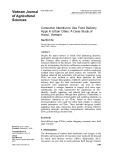
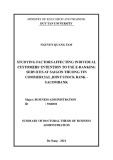
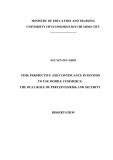
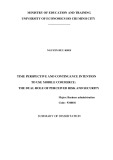



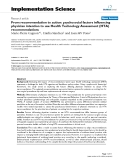







![Ngân hàng câu hỏi trắc nghiệm Lý thuyết Tài chính - Tiền tệ: Học phần [Mô tả thêm về nội dung học phần nếu có]](https://cdn.tailieu.vn/images/document/thumbnail/2025/20251003/kimphuong1001/135x160/26991759476043.jpg)

![Bài tập Tài chính doanh nghiệp có đáp án [kèm lời giải chi tiết]](https://cdn.tailieu.vn/images/document/thumbnail/2025/20250927/aimy1105nd@gmail.com/135x160/92021759119232.jpg)





